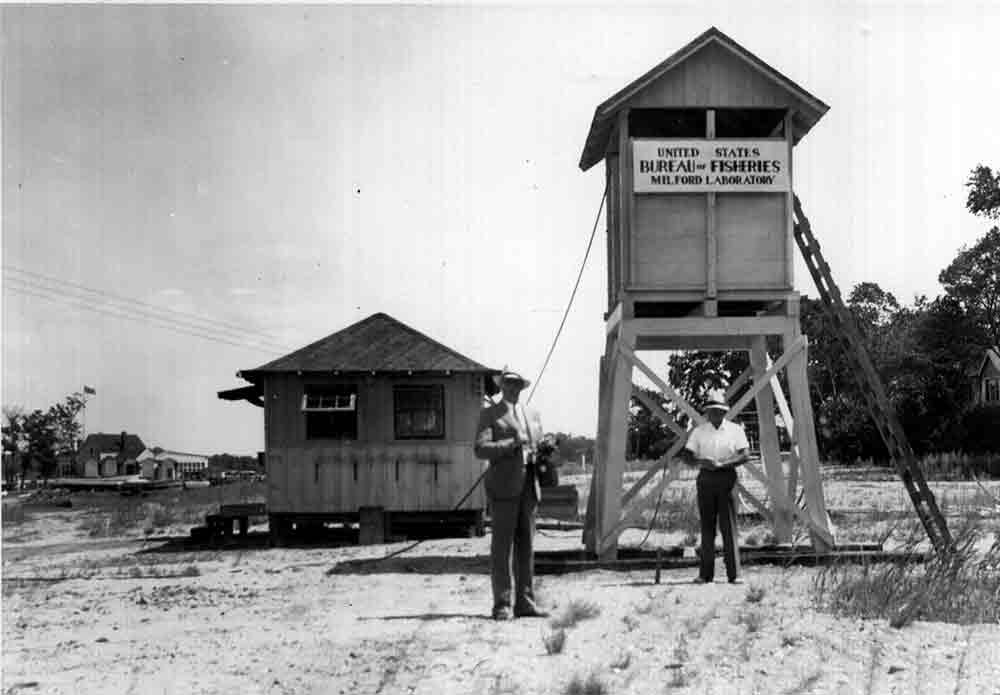Our Location
Part of the Northeast Fisheries Science Center, the Milford Lab is located about 70 miles northeast of New York City on Long Island Sound in Milford, Connecticut.
Annual Open House this Saturday, September 20, 9 AM-2 PM
What We Do
The Milford Laboratory, a world leader in aquaculture science, was established at the request of Connecticut’s oyster industry to help expand sustainable oyster harvests. Over the lab's illustrious history, NOAA scientists, working closely with industry and academia, have made fundamental contributions to the understanding of shellfish biology and reproduction (see "History," below). Today, the Milford Lab continues to conduct state-of-the-art science that informs management for the sustainable expansion of aquaculture, provides services to the shellfish aquaculture industry, and advances new technologies through collaborative research.
The lab employs approximately 20 full-time Federal research staff, with collaboration from contractors, visiting scientists, support staff and students. The scientific resources of the Milford Lab include a microalgal culture collection, a shellfish hatchery and tank farm, a flow cytometry facility, and a 49-foot research vessel, the R/V Victor Loosanoff.
Current projects include developing probiotics for use in oyster hatcheries, studying aquaculture gear as habitat for marine life, nutrient bioextraction studies, shellfish genetics research, offshore shellfish aquaculture potential, and responses of shellfish to ocean acidification.
Our Leadership

Management Team
Ecosystems and Aquaculture
Lisa Milke, Ph.D.
Director, Ecosystems & Aquaculture Division-
-
Aquaculture Innovation
Gary Wikfors, Ph.D., Lab Director - Milford, Chief, Aquaculture Innovation Branch
-
Aquaculture Innovation
-
-
Aquaculture Systems & Ecology
Shannon L. Meseck, PhD., Chief, Aquaculture Systems & Ecology Branch
-
Aquaculture Systems & Ecology
Our History

In 1931, Dr. Victor Loosanoff became the first full-time scientist in Milford using science to solve the biological problems facing Connecticut's oyster industry. Under his leadership, the Milford Laboratory made fundamental contributions to the understanding of shellfish biology and reproduction. Methodology was developed to spawn bivalve shellfish nearly year-round and to rear all life stages (embryonic, larval, and adult). This became known as the "Milford Method" and is still used worldwide in the aquaculture industry. Geneticists developed strains of shellfish with desirable traits, such as rapid growth. Mixtures of algae were cultured to support each shellfish life stage. This became the Milford Lab culture collection, established by Dr. Robert R.L. Guillard in the 1950s and built upon by Dr. Ravenna Ukeles throughout the 1960s-1980s. Scientists and industry professionals from around the world have used samples from this extensive algal library.
Since its founding, the lab has worked closely with the shellfish industry to help solve problems and increase production. Due to increased interest in the 1970s, Milford researchers investigated methods for culturing species such as bay scallops, surfclams, and hard clams. The lab became part of NOAA in the 1970s and research was broadened to reflect the fisheries management priorities of the National Marine Fisheries Service. Studies emphasized the impacts of environmental conditions and manmade stresses on the biological processes of various marine species. In particular, Milford scientists investigated the effects of heavy metals and organic compounds on the biological functions of key marine organisms, documenting which pollutants were causing specific effects.
With a focus on domestic seafood production, the Milford Lab continues to be a world leader in aquaculture science. The lab conducts research that informs the management and expansion of sustainable aquaculture, as well as seeks to understand interactions between aquaculture practices and the environment.

